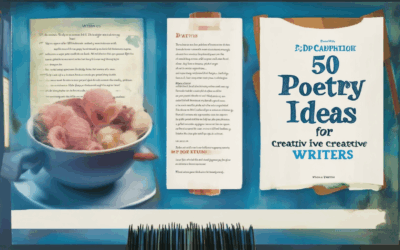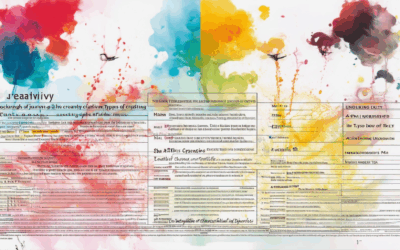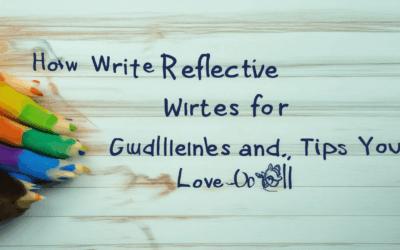Engaging in reflective prose blogging is a powerful way to delve deep into your thoughts, emotions, and experiences, offering a unique perspective that resonates with readers. This art form allows writers to explore complex ideas, connect personal narratives with broader themes, and foster meaningful connections through introspection. Whether you’re sharing poetic musings, philosophical reflections, or personal anecdotes, the act of reflective writing transforms mere storytelling into a transformative journey. By mastering the craft, you can unlock new layers of self-discovery and inspire others to reflect on their own lives. In this guide, we’ll explore the essential techniques, structures, and strategies to master reflective prose blogging, ensuring your words spark curiosity, provoke thought, and leave a lasting impact.
Key Takeaways
- Understanding Reflection: Learn how reflection in an English class fosters personal growth and deepens your connection with literature and themes.
- Methods of Reflection: Explore techniques like journaling and essay writing to unlock your thoughts and enhance learning.
- Importance of Reflection: Develop critical thinking, self-awareness, and empathy through structured, introspective writing.
- Incorporating Evidence: Strengthen your reflections by using quotes and examples to support your analysis.
- Application Beyond Texts: Reflect on broader topics like history and social issues to broaden your perspective.
- Overcoming Challenges: Embrace vulnerability and seek teacher guidance to navigate the emotional journey of reflective writing.

The 5 R’s of Reflective Writing
Reflective writing is a powerful tool for self-reflection, personal growth, and deepening understanding. It involves examining your thoughts, feelings, and experiences to foster insight and meaning. Below are the five key components of reflective writing, often referred to as the “5 R’s”:
- Report : This involves documenting your experiences in a factual and unbiased manner. It’s like taking notes or keeping a journal entry without judgment or interpretation. Effective reporting ensures that your thoughts are captured accurately for future review.
- Respond : In this stage, you engage with your thoughts and emotions. It’s about questioning assumptions, exploring feelings, and considering alternative perspectives. Responding helps you move beyond surface-level observations to deeper insights.
- Relate : Connecting your experiences to broader themes, patterns, or universal concepts. This step involves drawing parallels between your life and the world around you, helping you see your personal journey within a larger context.
- Reason : Analyzing and evaluating your thoughts and experiences. This includes logical thinking, identifying causes and effects, and making connections between ideas. Reasoning allows you to uncover underlying meanings and patterns.
- Reconstruct : Finally, you piece together your reflections into a coherent narrative. This involves organizing your thoughts, creating a story or theme, and communicating your findings effectively. Reconstruction turns raw materials into something meaningful and shareable.
By practicing these five steps, you can transform raw experiences into rich, insightful reflections that enrich your personal and professional life. Silken Drum encourages writers to explore these techniques to unlock their full potential and share their unique voices with the world. Explore our resources on reflective writing to discover more tools and techniques for your journey.
How to Write a Reflective Blog
Reflective blogging is a powerful way to share your thoughts, emotions, and experiences while fostering introspection and connection with your audience. Here’s a step-by-step guide to crafting an effective reflective blog post:
1. Choose Your Theme
Start by selecting a central theme or topic that resonates with you personally. Themes could include personal growth, overcoming challenges, learning from mistakes, or exploring a passion project. The theme should be something that invites others to relate to your journey.
2. Share a Personal Anecdote
Begin your post with a personal story or anecdote. This sets the stage for reflection and allows readers to connect with you on a human level. Whether it’s a triumph, a struggle, or a moment of doubt, authenticity is key.
3. Explore Emotions and Insights
Take time to delve into your emotions and unpack your experiences. Reflect on what you’ve learned, how you’ve grown, and what you’d do differently if given the chance. This exploration adds depth and vulnerability to your writing, making it more relatable.
4. Connect to Universal Themes
While your story may be personal, aim to connect it to broader themes or experiences that many people can identify with. This helps readers see themselves in your narrative, fostering empathy and a sense of community.
5. Analyze and Reflect
After sharing your story, analyze it thoughtfully. Consider the lessons you’ve learned, the patterns in your behavior, and how these experiences have shaped your perspective. This analysis can reveal new insights and provide valuable takeaways for your readers.
6. Share Your Growth and Learning
Reflect on how you’ve evolved as a result of your experiences. Discuss any mistakes you’ve made, challenges you’ve overcome, and how these have contributed to your personal growth. Highlighting your journey can inspire others to embrace their own growth opportunities.
7. Conclude with Intentions or Looking Forward
End your post by sharing your intentions moving forward or how you plan to apply what you’ve learned. This forward-looking perspective shows maturity and purpose, leaving readers motivated and inspired.
8. Edit and Polish
Before publishing, review your post for clarity, coherence, and emotional resonance. Ensure your writing flows naturally and that each section builds upon the last. Edit out any unnecessary details and tighten your prose for maximum impact.
By following these steps, you’ll create a reflective blog post that is both deeply personal and universally relatable. Remember, the goal is to invite readers into your world, offering them a glimpse into your mind and heart while providing them with valuable insights and inspiration.

What Are the Three Elements of Reflective Writing?
The three primary elements of reflective writing are:
- Description
- Reflective writing begins with a clear and vivid description of the event, experience, or situation. This involves recounting the details of what happened, how it made you feel, and what you observed. The description serves as the foundation for exploring deeper meaning.
-
Interpretation
- After describing the experience, the next step is to interpret its significance. This involves analyzing the emotions, motivations, and underlying themes. Interpretation goes beyond the surface level to uncover personal insights, connections, or lessons learned from the experience.
-
Outcome
- Finally, reflective writing concludes with reflecting on the outcomes of the experience. This includes discussing how the event impacted your life, what you learned, and how you plan to apply those lessons moving forward. The outcome often ties back to personal growth or change.
By following these steps, reflective writing allows for introspection and self-awareness, helping individuals gain deeper understanding of themselves and their experiences.

What is a Reflection in an English Class?
Reflection in an English class is a process that involves examining your thoughts, feelings, and experiences in relation to a specific topic, often involving literature, personal growth, or academic lessons. It allows students to delve deeply into their understanding of a subject, fostering critical thinking and self-awareness.
Key Aspects of Reflection:
- Definition : Reflection is akin to looking inward to gain insight and understanding. In an English class, this might involve analyzing a book, poem, or lecture to explore personal connections and growth.
- Purpose : The goal is to connect individual experiences with broader themes or concepts. This connection helps students develop a deeper appreciation for the material and themselves.
- Methods :
- Journaling : Regularly recording thoughts and feelings about assigned readings or lessons.
- Essays : Writing structured pieces that analyze chosen topics, exploring personal reactions and implications.
- Importance :
- Critical Thinking : Encourages students to question and analyze ideas.
- Self-Awareness : Helps identify strengths and areas for growth.
- Empathy : Fosters understanding of diverse perspectives through literature.
- Structure :
- Introduction : Sets the stage by introducing the topic.
- Body : Discusses the chosen material in detail, connecting it to personal experiences.
- Conclusion : Summarizes reflections and highlights personal growth.
- Assessment :
- Teachers evaluate depth of analysis, personal connection, and demonstrated growth.
- Insights and engagement with the material are key factors.
- Incorporation of Evidence :
- Using quotes or examples strengthens reflections.
- Connecting text to broader themes enhances analysis.
- Application Beyond Texts :
- Reflection can extend to historical events, social issues, or personal experiences, offering versatility in topics.
- Challenges :
- Overcoming vulnerability and fear of judgment is common.
- Teacher guidance helps students navigate these challenges effectively.
Conclusion:
Reflection in an English class is a transformative tool, aiding personal development and academic growth. It encourages deeper thinking, self-awareness, and a richer understanding of subjects, benefiting students’ articulation and insightfulness.
How to Begin a Reflective Essay
A reflective essay begins with a thoughtfully crafted introduction that grabs attention and sets the stage for the rest of your piece. Here’s a step-by-step guide to help you get started:
- Start with a Hook: Begin your essay with a compelling hook to engage your reader. Common types of hooks include:
- Thought-provoking questions
- Anecdotes or personal stories
- Surprising statistics or facts
- Poignant quotes or statements
- State Your Purpose Clearly: Include a thesis statement that outlines the central theme or lesson of your essay. This helps guide the reader through your narrative.
- Set the Tone Appropriately: Establish the tone early on. Is your reflection introspective, analytical, or conversational? This choice will influence the rest of your essay.
Choosing a Reflection Technique
Reflective essays often benefit from a structured approach. Consider these methods to organize your thoughts:
- Journaling Approach: Write down your initial thoughts and feelings about the topic. This allows you to explore your emotions and ideas freely before organizing them.
- Mindful Observation: Pay attention to your surroundings and internal state. This technique helps you connect your personal experiences with broader themes.
- Life Events Reflection: Reflect on specific life events or moments that have shaped your perspective. Connecting personal experiences to universal themes strengthens your essay.
Developing the Body of Your Essay
Once you’ve set the foundation, delve deeper into your thoughts and experiences. Here’s how to flesh out your essay:
- Use Narrative Techniques: Tell stories or recount specific incidents that illustrate your reflections. This makes your essay more relatable and engaging.
- Explore Multiple Perspectives: Consider different viewpoints or interpretations of your experiences. This adds depth and complexity to your reflection.
- Incorporate Emotional Vulnerability: Authenticity is key in reflective writing. Share your true feelings and struggles to resonate with your audience.
Concluding Your Reflective Essay
End your essay by summarizing your reflections and their significance. A strong conclusion ties everything together and leaves the reader with something to ponder:
- Restate Your Thesis: Reiterate your central theme or lesson. This reinforces your essay’s purpose and gives closure.
- Share Your Growth or Insight: Highlight how your reflections have changed your understanding or perspective. This demonstrates the value of your journey.
- Inspire Action or Contemplation: End with a thought-provoking statement or call to action that encourages readers to reflect on their own lives.
By following these steps, you’ll craft a meaningful and impactful reflective essay that invites others to join your journey of self-discovery and growth. Visit our creative writing community for more tips and inspiration!

The Three Basic Parts of a Reflection Paper
A reflection paper typically consists of three primary components, each serving a distinct purpose in conveying personal growth, insight, and analysis. These components are designed to guide the reader through the author’s journey of self-discovery and understanding.
- Introduction
The introduction sets the stage for the reflection by introducing the topic, providing background information, and outlining the purpose of the paper. It often begins with a hook, such as a personal anecdote or a thought-provoking statement, to engage the reader. The introduction may also include a thesis statement that encapsulates the central theme or argument of the reflection. - Body
The body is the most extensive section of the reflection paper. Here, the author delves into their personal experiences, emotions, and observations. They analyze these elements to identify patterns, growth, or lessons learned. The body may also incorporate external perspectives, such as quotes, research, or comparisons to broader themes, to enrich the reflection. This section often includes sub-sections or paragraphs that explore specific aspects of the experience in detail. - Conclusion
The conclusion wraps up the reflection by summarizing the key insights gained throughout the paper. It reflects on the journey taken and the lessons learned, offering a sense of closure and completeness. The author may also express their evolving perspective or future intentions, leaving the reader with a lasting impression of the transformative experience.
By organizing the reflection paper into these three parts, authors can effectively communicate their personal growth and deepen their understanding of a particular topic or event.




0 Comments